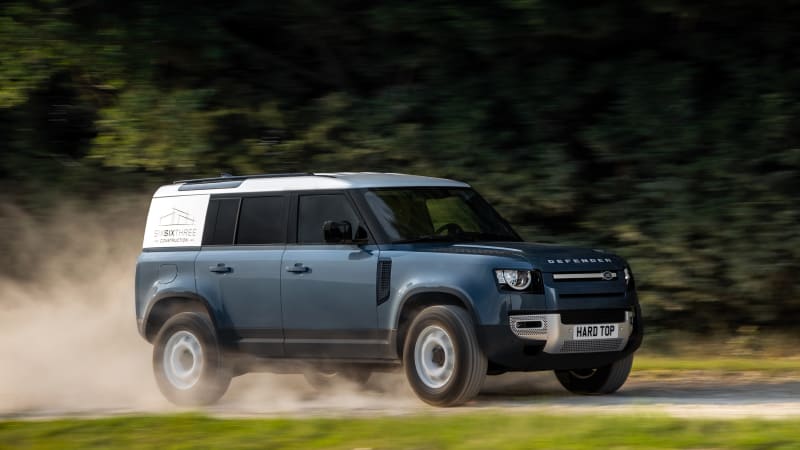
Land Rover hopes to mute the critics who claim moving the Defender upmarket alienates commercial users by launching an entry-level model named Hard Top. It’s a cheaper, relatively basic variant of the SUV designed to feel more comfortable taking workers to fix power lines than carrying a family on a weekend camping trip.
We got a preview of the Hard Top when the Defender made its global debut during the 2019 edition of the Frankfurt auto show, but Land Rover chose not to say much about the model in order to focus on more expensive and more profitable variants that are better aligned with its luxurious image. With those out of the way, the firm explained the Hard Top (a name which, in Land Rover’s glossary, traces its roots to 1950) rides on the exact same aluminum-intensive unibody platform as the Defender, and it’s being developed by its Special Vehicle Operations division. Short- and long-wheelbase models dubbed 90 and 110, respectively, will be available.
Land Rover hasn’t published technical specifications yet, but it’s reasonable to assume this version of the Defender won’t get a V8; you’re more likely to find a turbodiesel engine under the hood. Both models will receive an independent steel suspension, though the 110 will be offered with an adaptive air suspension at an extra cost, and they’ll be able to tow up to 7,700 pounds when properly configured. Four-wheel drive will come standard.
Steel wheels will underline the Hard Top’s commitment to function-over-form design, and Land Rover will replace the rearmost window with a metal panel where buyers can paint their company’s logo and/or contact information. While photos of the interior remain under wraps, Land Rover explained both Hard Top models will offer two front seats in their most basic configuration, but an optional center jump-seat will increase their seating capacity to three. Motorists who need second- or third-row seats will need to move up in the trim level hierarchy, because the Hard Tops were developed for cargo-hauling. The rear opening is big enough to swallow a standard-sized pallet.
Land Rover can only go so far in its quest to strip content from the Defender, and the Hard Top remains considerably more high-tech than the outgoing Defender. It features Apple CarPlay and Android Auto compatibility, it can receive over-the-air updates, and it’s equipped with an array of electronic driving aids like a ClearSight Rear-View Mirror, Advanced Tow Assist, a 360-degree camera, as well as Terrain Response 2. In the original Defender, driving aids were limited to pedals, a lever for the handbrake, another one to shift gears, and a steering wheel.
In the United Kingdom, the Land Rover Defender Hard Top will go on sale in late 2020 with a base price of £35,500 plus tax, a sum that represents approximately $44,000 at the current conversion rate. That figure makes it about £5,000 (roughly $6,200) cheaper than the cheapest non-commercial variant sold in England. Pricing for the American market hasn’t been announced yet, and we don’t know if the Hard Top will be sold on this side of the Atlantic. Autoblog reached out to Land Rover for clarification, and we’ll update this story if we learn more.
When it lands, one of its main rivals will be the Ineos Grenadier, which is being developed by one of the largest chemical producers in the world. It sounds like the truck will be much closer to the original Defender than the current-generation model, in part because it will receive body-on-frame construction and solid axles. Here again, we don’t know whether the Grenadier will be sold in the United States, or if it will exclusively be available on the other side of the pond. Production is tentatively scheduled to begin in Wales in 2021.
